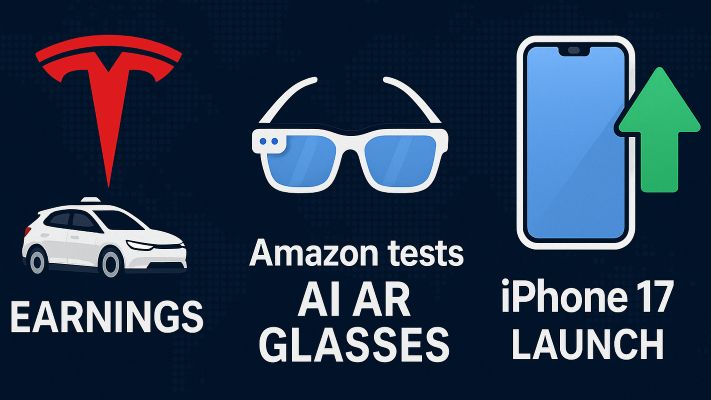AI Navigation
- articleAI Trends
- lightbulb_2AI Tips
- assistant_navigationAI Navigation
- heatHot Articles
- emergency_heat_2Hot Tips
- format_list_numberedPrompt Formatter
- psychologyTest Center(RPI)
2025-10-23 · 24-Hour AI Briefing: Tesla’s earnings & Robotaxi milestone, Amazon tests AI AR glasses, iPhone 17 launch momentum
In the past 24 hours, intelligence is moving from cloud to street level: Tesla sharpened its “car + compute + Robotaxi” push, Amazon brought AI into last-mile logistics with AR, and Apple’s iPhone 17 launch data suggests a stronger premium upgrade cycle.

1. Tesla Q3 FY2025: record deliveries, profit pressure, Robotaxi to go safety-driver-free in Austin this year
Tesla reported total revenue of $28.095B (+12% YoY) and net income of $1.373B (-37% YoY). CEO Elon Musk said that by year-end, most Austin service zones will run Robotaxi without a safety driver. The Austin Robotaxi fleet has surpassed 250,000 miles driven.
Commentary:
Deliveries hit a record 497k (+7.3% YoY) and energy storage deployments reached 12.5 GWh (+81% YoY), showing multi-engine growth. Yet vehicle gross margin pressure and elevated investment kept net profit subdued. With “AI/compute/datacenters + Robotaxi” advancing in parallel, capex and R&D intensity should remain high. Free-cash-flow elasticity near term will hinge on cost-down, mix, and the pace of energy storage scale-up. Removing the safety driver across wide areas of Austin would mark a decisive step from pilot to early commercialization; if executed, FSD shifts from driver assistance to supply-side mobility, opening the door to a valuation re-rate.
2. Amazon pilots AI-powered AR glasses for drivers: sorting, nav, scan, photo proof—at a glance
Amazon is testing AI AR glasses for delivery drivers that overlay parcel sorting cues, walking navigation, scanning confirmations, and photo proof directly in view—aiming to boost efficiency and safety as a hands-free “last-mile” solution.
Commentary:
Compressing multi-step PDA/handheld workflows into “heads-up + gaze/voice/tap” can lift stop-level throughput, first-attempt delivery rates, and situational safety (less heads-down time). The current build emphasizes foundational navigation; next iterations are slated for real-time hazard alerts and low-light adaptation, with prescription lens support for comfort. Shaving “a few seconds per parcel” scales meaningfully at Amazon volumes, but all-day wearability and fatigue management will determine true adoption.
3. iPhone 17 sales outpace iPhone 16 by 14% in first 10 days across US/China; iPhone Air trimmed as flagships ramp
iPhone 17 models sold 14% more than iPhone 16 in their first 10 days in the US and China, lifting Apple shares to record highs. iPhone Air underperformed; Apple is cutting Air production and increasing flagship orders.
Commentary:
Initially planned at 10%–15% of total volume (≈8–13M units) as a prelude to a 2026 foldable, iPhone Air’s “available now” proposition didn’t sway buyers—who chose to wait for flagships instead. Trimming Air and leaning into flagships should ease channel inventory risk, improve product mix, and support unit gross margin. Crucially, iPhone 17’s launch strength in both the US and China reaffirms Apple’s leadership at the high end.
AI and hardware are meeting in the middle—on roads, at doorsteps, and in pockets. From “car–cloud–compute” to on-device intelligence, tightly coupled product–scenario loops are ushering in the next wave of consumer computing.
For more cutting-edge AI insights, business intelligence, and technology trends, visit:
https://iaiseek.com/en
Want to catch up on the last 48 hours of major AI news? Read: